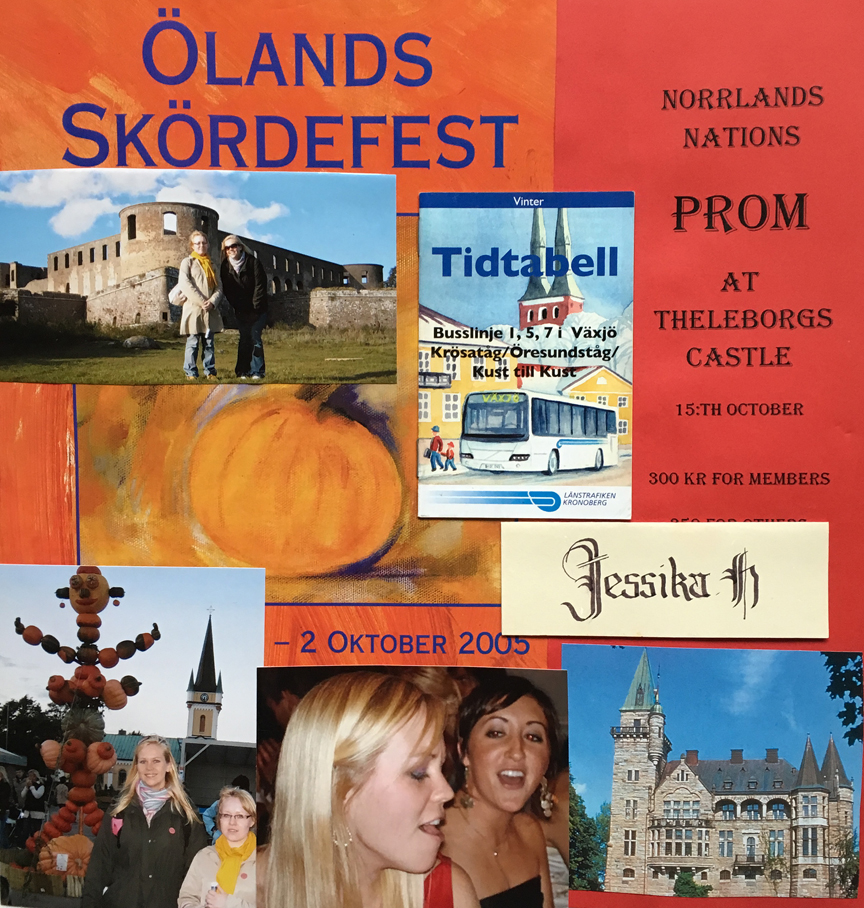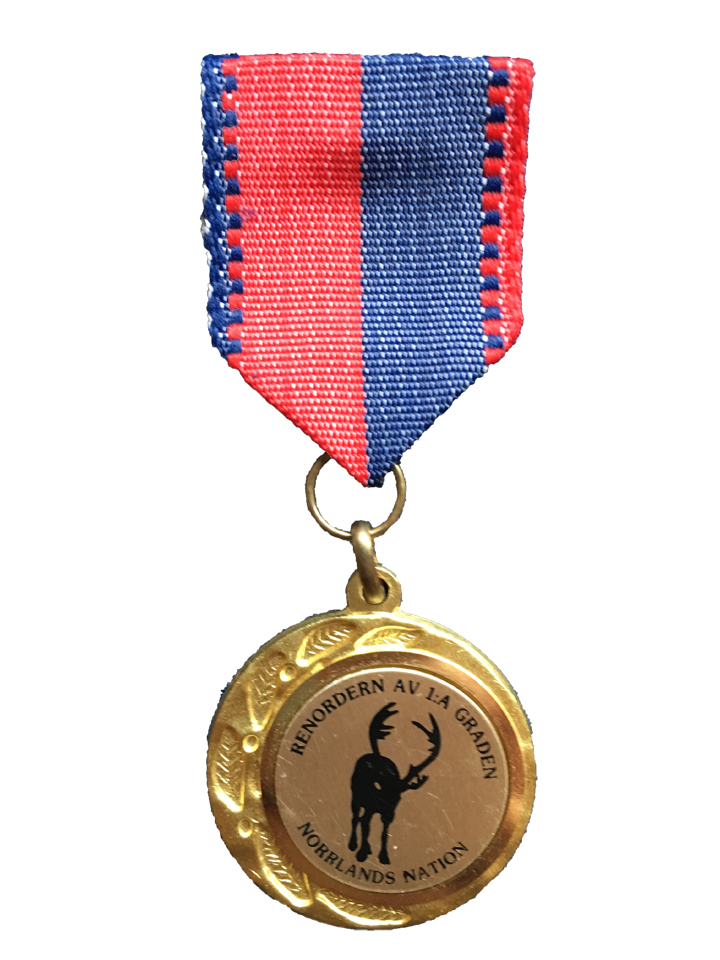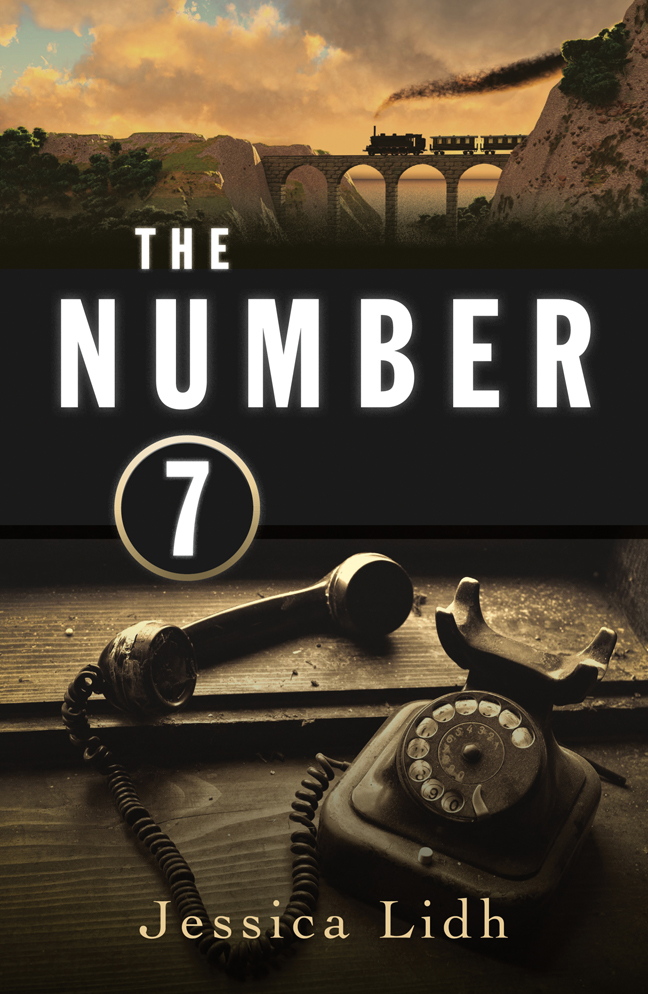Crazy, obnoxious or American: An Innocent traveler in Sweden
Sweden made it easy for me to fall in love with her. In fact, I had anticipated falling in love with her. How many stories had I listened to my family tell about the country with green fields and red houses, the country from which our family originated? In 2005, determined to discover this landscape and its people for myself, I enrolled for a year at the university in Växjö, Sweden.
-
 This is a page of my Swedish scrapbook. The red paper on the right is the cover of the program from the Prom at Theleborgs Castle. The photo on the bottom-right is of the castle itself. The photo in bottom-center is of me and Erin the night of the Prom. Photo bottom-left and top-left is me and my Finnish friend at Ölands Skördefest.
This is a page of my Swedish scrapbook. The red paper on the right is the cover of the program from the Prom at Theleborgs Castle. The photo on the bottom-right is of the castle itself. The photo in bottom-center is of me and Erin the night of the Prom. Photo bottom-left and top-left is me and my Finnish friend at Ölands Skördefest. -
-
Sweden made it easy for me to fall in love with her. In fact, I had anticipated falling in love with her. How many stories had I listened to my family tell about the country with green fields and red houses, the country from which our family originated?
-
 1st class, Orden of the Reindeer, Norrlands Nation (Student fraternity from Sweden’s northernmost province, Norrland)
1st class, Orden of the Reindeer, Norrlands Nation (Student fraternity from Sweden’s northernmost province, Norrland) -
-
Växjö, whose name derives from väg (road) and sjö (lake), immediately captured my heart. It is the quintessential city where the road meets the lake. Within minutes of landing at Växjö’s tiny airport, I wanted nothing more than to just blend in with the local community and get in touch with my Swedish roots. Naively, I believed there was a standard code of conduct, practiced by all Swedish people, and if I could just get my hands on a copy of said code, I would succeed at convincing everyone that I was a “real” Swede.
-
 Jessica Lidh is the author of <a href="http://www.jessicalidh.com" target="_blank">"The Number 7" </a> (ISBN 9781440583063. Merit Press, December 2014)
Jessica Lidh is the author of <a href="http://www.jessicalidh.com" target="_blank">"The Number 7" </a> (ISBN 9781440583063. Merit Press, December 2014) -
In a sense, I wanted to de-Americanize myself — if only for the two semesters I’d be there — to allow Sweden the chance to teach me something. Something about its culture, its heritage, its people. I wanted Sweden to teach me something about myself.
-
Resolute in my quest, I attempted to pass myself off as a bonafide Swede. My first attempt lasted an hour.
-
As soon as I arrived at Växjö Universitet (now Linnaeus University), I decided to walk from the campus to Växjö’s town square. The bike path into town is a beautiful stretch of pavement running along the perimeter of Växjösjön to the city’s central shopping district. As I walked the route, I greeted every stranger I met with a friendly "hey!" expecting my inflection to convince the locals I was one of them. But instead of enthusiastic greetings in return, each passerby looked at me queerly. Most did utter a quick "hey" as they scurried away, never making eye contact. But some didn’t look at me — or even acknowledge me at all.
-
"My pronunciation must be off," I told myself, and continued on my way. It wasn’t until weeks later that my Swedish boyfriend laughed at my behavior and told me, "We have a joke here in Sweden that the only people who say 'hello' to strangers are drunk, crazy or American."
-
How had I so easily become a punch line? Well, I would not make the same mistake twice.
-
Not long after that at a dinner party with new friends, I continued my quest to prove my Swedish authenticity. "Just do as they do," I whispered to myself before the meal. As my hosts began the first round of "Helan Går" at the dinner table, I clutched my snaps glass and imitated the best I could.
-
Perhaps I didn’t know the words, but I could certainly mimic their smiles and their good cheer. And, when it came time to drink the aquavit, I did as I’d always seen my American friends do: I swallowed the entire shot. After finishing the song and my drink, I looked around the table to see I was the only guest to swallow all the contents of my glass. The others had only taken a small sip while mine now sat empty. I sunk a little in my chair, my cheeks burning with more than the sting of the alcohol.
-
Finally, resolute in my pursuit to be as authentic a Swedish girl as possible, I bought tickets to an evening gala hosted by Swedes for Swedes at the campus castle. "I’ll do whatever I have to do!" I promised as I and my American friend, Erin, dressed up in our finest eveningwear and sat down to a formal meal.
-
This time I remembered my prior missteps. Now, I waited to greet the people at my table until they greeted me first. When the toastmasters sang "Helan Går," I merely took a small sip from my glass. Everything was going so well. My Swedish companions were impressed with my Scandinavian decorum. But it wasn’t until the evening’s close that came the ultimate test of my allegiance, and I was faced with the question of how far I was willing to go to prove my loyalty to this new country. Was I really willing to shed my American identity for a Swedish one?
-
As the hosts ushered small groups of dinner guests out of the great hall and into an antechamber, Erin and I exchanged nervous glances. Where was everyone going? Would we be invited to go, too?
-
"Don’t worry," one of the toastmasters told us. "We’re waiting to take you two last so we can do it in English." Erin and I nodded and smiled though we had no idea what for. Do what in English?
-
At long last, it was our turn to exit the room. Our hosts took us each by the hand and led us into a private, dimly-lit library. The room smelled of old cigars and faded memories. But it wasn’t the dripping candles in the candelabra or the antiquated books on the bookshelves that caught my eye. It was something else. There, in the center of the wall before us, hung a mounted moose head. I came face to face my Swedish alter ego in the shape of an antlered mammal.
-
I won’t pretend to recall what exactly was said in this intimate encounter. I even called Erin before writing this article, now 10 years later, to see if she could remember, but neither of us could. Not exactly. The one part we each remember, however, is the same. At some point during those five minutes of secret initiation, Erin and I were each asked whether we pledged allegiance to the moose. To me, it was the ultimate test. All that I’d worked so hard for was summed into one simple question. Did I, or did I not, pledge allegiance? And suddenly, it wasn’t the eyes of a taxidermy moose that I stared into, but the eyes of Lady Liberty. Which country would I choose? Where did I belong? Who was I, really? Deep down inside? Here was the moment of self-actualization I’d been waiting for.
-
And as I stared into those shiny glass eyes, I realized how the toastmasters had waited to take me and Erin last. They hadn’t excluded us. But they hadn’t grouped us together with other Swedes, either. They knew we were different, and despite this difference, we were still welcomed to participate in their important university ritual. I was one of them. Somehow, in that minute, I was both American and Swede simultaneously.
"So do you pledge?" The toastmasters waited for my answer.
"Javisst. Of course." -
By Jessica Lied
-
Jessica Lidh penned her first novel The Number 7 (ISBN 9781440583063, Merit Press, December 2014) in 2014. The author whose book and Swedish experience was covered in December 2014 and early 2015 - My Not-So-Swedish Family Christmas pulls inspiration from her Swedish heritage and experiences as a high school teacher in suburban Maryland. In encouraging young minds to suck the marrow out of life, Lidh often uncovers the fascinating and hilariously horrifying insights of the 21st century teenager. When she isn’t fervently teaching or writing, Lidh loves to watch old musicals, bake Swedish cinnamon buns and go on imaginary bear hunts with her daughter, Elsa.
-
For more info, see www.jessicalidh.com
-
-
